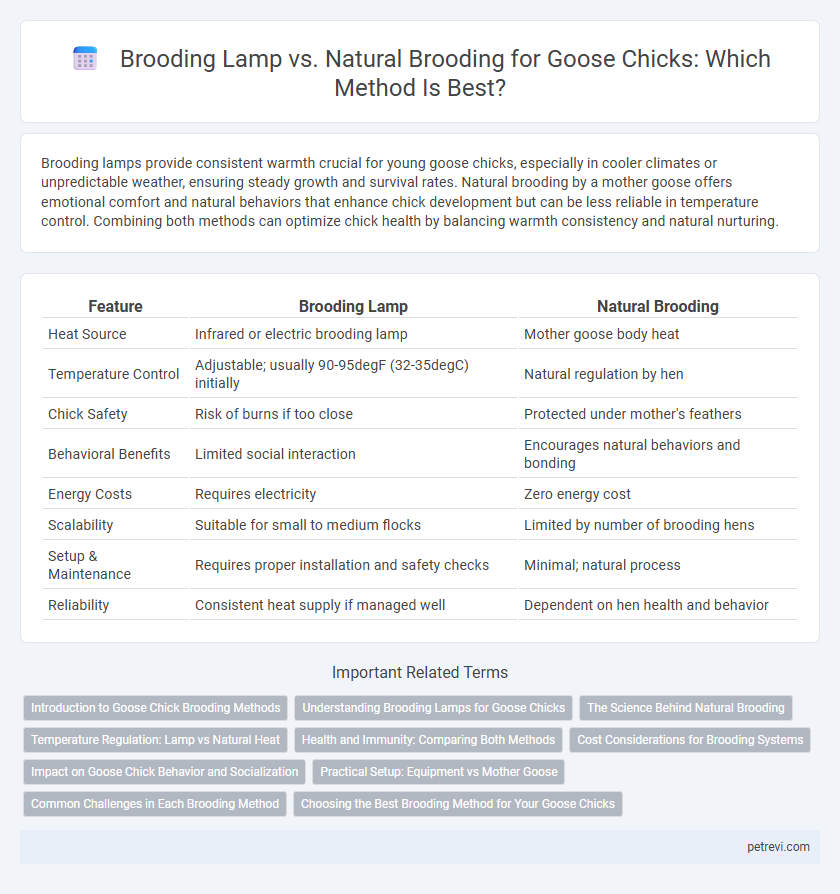Brooding lamps provide consistent warmth crucial for young goose chicks, especially in cooler climates or unpredictable weather, ensuring steady growth and survival rates. Natural brooding by a mother goose offers emotional comfort and natural behaviors that enhance chick development but can be less reliable in temperature control. Combining both methods can optimize chick health by balancing warmth consistency and natural nurturing.
Table of Comparison
| Feature | Brooding Lamp | Natural Brooding |
|---|---|---|
| Heat Source | Infrared or electric brooding lamp | Mother goose body heat |
| Temperature Control | Adjustable; usually 90-95degF (32-35degC) initially | Natural regulation by hen |
| Chick Safety | Risk of burns if too close | Protected under mother's feathers |
| Behavioral Benefits | Limited social interaction | Encourages natural behaviors and bonding |
| Energy Costs | Requires electricity | Zero energy cost |
| Scalability | Suitable for small to medium flocks | Limited by number of brooding hens |
| Setup & Maintenance | Requires proper installation and safety checks | Minimal; natural process |
| Reliability | Consistent heat supply if managed well | Dependent on hen health and behavior |
Introduction to Goose Chick Brooding Methods
Goose chick brooding methods include using a brooding lamp or natural brooding, each playing a crucial role in early chick development. A brooding lamp provides consistent heat and controlled temperature, essential for maintaining optimal warmth in the first weeks of life. Natural brooding relies on the mother goose's body heat and behavior, fostering natural instincts and social bonding for better chick survival and growth.
Understanding Brooding Lamps for Goose Chicks
Brooding lamps for goose chicks provide controlled heat essential for their early development, typically emitting infrared light to maintain a consistent temperature of around 90degF in the first week. Unlike natural brooding, which depends on the mother goose's warmth and presence, brooding lamps enable precise temperature regulation and reduce risks linked to overcrowding or cold stress. Ensuring proper lamp placement and adjusting heat based on chick behavior promotes optimal growth and minimizes mortality rates in commercial or indoor settings.
The Science Behind Natural Brooding
Natural brooding in goose chicks harnesses the hen's body heat, humidity regulation, and protective behavior, which collectively promote optimal chick development and immune function. Unlike brooding lamps that provide only artificial warmth, the natural brooding environment supports behavioral thermoregulation and social bonding critical for gosling survival. Scientific studies reveal that maternal interactions during natural brooding enhance stress resilience and growth rates in goslings.
Temperature Regulation: Lamp vs Natural Heat
Brooding lamps provide consistent and adjustable temperature control essential for maintaining the optimal 90-95degF (32-35degC) range during the first week of goose chick development. Natural brooding relies on the mother goose's body heat, which can fluctuate with ambient conditions, potentially causing uneven warmth and stress in chicks. Accurate temperature regulation with lamps reduces the risk of hypothermia and promotes uniform growth, whereas natural brooding may require supplemental heat in colder climates to ensure chick survival.
Health and Immunity: Comparing Both Methods
Brooding lamps provide a controlled heat source that ensures consistent warmth for goose chicks, reducing the risk of hypothermia but may limit exposure to natural environmental factors that boost immune development. Natural brooding encourages stronger innate immunity by exposing chicks to varied temperatures and microbes, fostering resilience but increasing vulnerability to cold stress and pathogens. Balancing temperature control and natural environmental exposure is crucial for optimizing goose chick health and immune system strength.
Cost Considerations for Brooding Systems
Brooding lamps offer a cost-effective initial investment with lower energy consumption compared to natural brooding, which requires consistent heat sources to maintain optimal temperatures for goose chicks. Natural brooding eliminates the need for electricity by utilizing the mother goose's body heat, reducing ongoing operational costs, but may limit scalability in commercial settings. Evaluating long-term expenses, brooding lamps incur higher utility costs while providing controlled and consistent warmth, essential for maximizing survival rates during early development stages.
Impact on Goose Chick Behavior and Socialization
Brooding lamps provide consistent warmth that can influence goose chick behavior by reducing their need to huddle, promoting independent movement and early exploration. Natural brooding by a mother goose encourages instinctive behaviors and social bonding, fostering stronger chick interaction and hierarchy development. Studies indicate that natural brooding enhances socialization skills and stress resilience compared to artificial heat sources.
Practical Setup: Equipment vs Mother Goose
Brooding lamps provide consistent heat and controlled conditions essential for early-stage goose chicks, ensuring optimal growth when natural warmth from a mother goose is unavailable. Equipment setups typically require heat lamps, temperature regulators, and safe enclosures to maintain a stable environment, mimicking maternal care. In contrast, a mother goose naturally offers warmth, protection, and social interaction, reducing the need for artificial equipment but requiring space and careful monitoring of her behavior.
Common Challenges in Each Brooding Method
Brooding lamps often present challenges such as uneven heat distribution and increased risk of burns or dehydration in goose chicks due to improper temperature control. Natural brooding, while providing warmth through the mother goose's body heat, can result in inconsistent temperature exposure and increased vulnerability to predators or environmental stressors. Both methods require careful monitoring to prevent health issues like hypothermia or stress that can affect chick survival and growth rates.
Choosing the Best Brooding Method for Your Goose Chicks
Choosing the best brooding method for goose chicks involves comparing brooding lamps and natural brooding under a mother goose. Brooding lamps provide consistent, easily controlled heat important for temperature regulation and early development during the first few weeks. Natural brooding promotes healthier social behavior and immune strength but requires a broody goose and cannot guarantee uniform warmth, making brooding lamps a preferred option for large-scale or controlled environments.
Brooding lamp vs Natural brooding for Goose chicks Infographic

 petrevi.com
petrevi.com